The Living Legacies 2017 Research Fund is now CLOSED
Details forms and guidance notes, can be found by clicking here.
Awards will be announced on Wednesday 16th November 2016.
The Living Legacies 2017 Research Fund is now CLOSED
Details forms and guidance notes, can be found by clicking here.
Awards will be announced on Wednesday 16th November 2016.
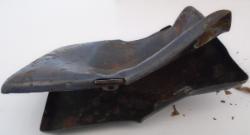 On 22nd September as part of a series of roadshows with Ards and North Down Borough Council, the Living Legacies team were in Holywood Library supporting ‘Holywood Commemorates the First World War’, a community-focused event organised by the Holywood and District U3A Local History Group. We were keen to gather some new oral histories and to record war-related memorabilia digitally, and were delighted to receive our first German contribution to the online archive. Klaus Wagner, son of WW1 German soldier Karl Wagner ,brought us a fascinating set of objects relating to his father’s war experience and shared some of the story which we felt was unique and worthy of publishing here. Karl had joined the Bavarian Artillery aged just 17. While he and three colleagues were firing a cannon at the Battle of Passchendaele on October 24th 1917, the French attacked with heavy artillery. Karl’s arm was severely injured, although, as the shrapnel-hit cigarette case pictured took most of the impact, he survived. This was the end of the war for him. He was awarded the Iron Cross First Class. The most remarkable part of the story is that Karl’s arm was re-attached and full functionality in his hand was restored.He often showed his ‘hole’ in the arm to
On 22nd September as part of a series of roadshows with Ards and North Down Borough Council, the Living Legacies team were in Holywood Library supporting ‘Holywood Commemorates the First World War’, a community-focused event organised by the Holywood and District U3A Local History Group. We were keen to gather some new oral histories and to record war-related memorabilia digitally, and were delighted to receive our first German contribution to the online archive. Klaus Wagner, son of WW1 German soldier Karl Wagner ,brought us a fascinating set of objects relating to his father’s war experience and shared some of the story which we felt was unique and worthy of publishing here. Karl had joined the Bavarian Artillery aged just 17. While he and three colleagues were firing a cannon at the Battle of Passchendaele on October 24th 1917, the French attacked with heavy artillery. Karl’s arm was severely injured, although, as the shrapnel-hit cigarette case pictured took most of the impact, he survived. This was the end of the war for him. He was awarded the Iron Cross First Class. The most remarkable part of the story is that Karl’s arm was re-attached and full functionality in his hand was restored.He often showed his ‘hole’ in the arm to 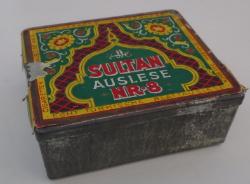 Klaus and his friends. Some of the bone fragments and pieces of shrapnel from this injury are still kept in the cigarette case by his son as a reminder of the violence of war for all nations involved in it. Karl also kept a diary –written in Old German---which is being translated, as are some 90 letters to his family, to be shared with the current generation. Klaus is now living in Holywood with his Dungannon-born wife Isabella. His story and the objects which he brought along reinforced the value of local history groups and Living Legacies conducting public engagement activities.
Klaus and his friends. Some of the bone fragments and pieces of shrapnel from this injury are still kept in the cigarette case by his son as a reminder of the violence of war for all nations involved in it. Karl also kept a diary –written in Old German---which is being translated, as are some 90 letters to his family, to be shared with the current generation. Klaus is now living in Holywood with his Dungannon-born wife Isabella. His story and the objects which he brought along reinforced the value of local history groups and Living Legacies conducting public engagement activities.
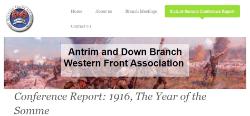 On 8th October 2016 the Antrim and Down branch of the WFA held its annual conference on the history, legacy and importance of political and military events during 1916. Twenty-nine people attended.
On 8th October 2016 the Antrim and Down branch of the WFA held its annual conference on the history, legacy and importance of political and military events during 1916. Twenty-nine people attended.
Dr Tim Bowman (University of Kent) opened the conference with a broad overview of political and military events during 1916. He said that while much public attention in Northern Ireland had focused on the 1916 Easter Rising and 1st July these were only two events in a global war. He listed other major episodes including the titanic Battle of Verdun, fought between Germany and France and the five battles of the River Isonzo, where Italy repeatedly attacked Austria-Hungarian positions along that river.
Dr William Butler (University of Kent) followed talking about recruitment in Ireland and the various attempts, propaganda and initiatives the military authorities used to try and increase enlistment amongst Irishmen in the second half of the war.
PhD candidate Heather Montgomery (Queen’s University Belfast) finished the morning session with a discussion on research into the nature and type of infantry training conducted at Great War army camps across Ireland. She explained how she had used archeological techniques examine landscape features in training camps which could possibly be training trenches but were not recorded on official maps or plans. She had uncovered extensive networks of previously unknown practice and assembly trenches and concluded that the army training efforts to prepare soldiers for combat in France was much more sophisticated and extensive than had been previously believed.
Professor Richard Grayson (Goldsmiths, University of London) opened the afternoon session. He talked about recruitment and military service of men from West Belfast arguing that their experience was much more complex than popular perceptions suggested.
He was followed by Nicholas Perry who examined the relationships that Major General Oliver Nugent, Commander of the 36th Ulster Division from 1915 to 1918, had with the commanders of Armies in which his division was deployed during his command.
The final speaker of the day was Professor Andrew Lambert (King's College London) who discussed the importance of the Battle of Jutland. He said the Battle was the only major naval battle of World War One, and the only full-scale fleet engagement between Dreadnought battleships. Although the Royal Navy lost more men and ships, the final verdict of the Battle of Jutland was that the German High Seas Fleet had been defeated and driven back into port, unable to face the superior firepower of the Grand Fleet. Admiral Sir John Jellicoe’s tactics were criticised by some, but after the battle the Royal Navy retained command of the sea, upon which the entire allied war effort depended. The German response to their defeat was unrestricted U-boat warfare, a massive violation of international law, which helped bring the United States into the conflict.
The final element of the conference was a visit of HMS Caroline, the last surviving warship that fought at Jutland. The ship has been recently opened to the public and the conference was given a tour around the ship by Curator Victoria Millar.
The Antrim and Down Branch would like to thank Somme Belfast 100, Living Legacies 1914-18 public engagement centre and PRONI for their assistance and support that helped make this conference possible.
Tom Thorpe
Co Chair
12.10.2017
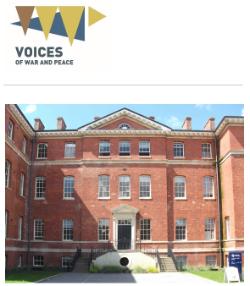 Research Bursary: Impact of First World War on medicine and healthcare. Researcher to be appointed in October 2016. Project to be complete by September 2017. This is a paid research opportunity.
Research Bursary: Impact of First World War on medicine and healthcare. Researcher to be appointed in October 2016. Project to be complete by September 2017. This is a paid research opportunity.
Project Details
Worcester’s Medical Museums are looking for a Researcher to study the impact of the First World War on developments in medicine and healthcare in Worcestershire (and beyond). This will include the areas and disciplines of medicine covered in displays at both museums, to include (but not limited to): Home Medicine, Medical Science, Surgery, Anaesthetics, War surgery, and First Aid. The Researcher will have access to Worcester Medical Museums’ collection of objects, books and photographs, and archives held at The Hive. The Researcher will theme and edit their findings for printing in a mini publication, and for display on a pop-up banner to be toured. To view our previous research publication about the story of the first female Resident Medical Officer at Worcester Infirmary, click here.
This project is funded by the Heritage Lottery Fund, and part of the larger Worcestershire World War 100 partnership with heritage organisations and attractions in Worcestershire. The found research will enable us to share the broader picture of developments in medicine and healthcare during this time, and enable visitors to comment on the subject matter through social media, display panels at the George Marshall Medical Museum and The Infirmary, and the ‘Debating Space’ at The Infirmary. We will also publish the findings in a mini booklet available both online and in print.
Supervision
The Researcher will have regular supervision sessions with Dr. Frank Crompton, Associate Fellow at the University of Birmingham Centre for the History of Medicine, and longstanding PhD supervisor for the University of Worcester.
To Apply
To apply for this role please send a current CV and sample of your writing no longer than 2 sides A4 from a completed research document (e.g. dissertation, essay, published article) to Mark Macleod, Head of The Infirmary at m.macleod@worc.ac.uk or The Infirmary, University of Worcester, Castle Street, Worcester, WR1 3AS by 12pm on Friday 21st October, 2016 with appointment before the end of October.
|
The major art installation Blood Swept Lands and Seas of Red at the Tower of London, marked one hundred years since the first full day of Britain's involvement in the First World War. Created by artists Paul Cummins and Tom Piper, 888,246 ceramic poppies progressively filled the Tower's famous moat between 17 July and 11 November 2014. Each poppy represented a British military fatality during the war. The poppies encircled the iconic landmark, creating not only a spectacular display visible from all around the Tower but also a location for personal reflection. The scale of the installation was intended to reflect the magnitude of such an important centenary and create a powerful visual commemoration. All of the poppies that made up the installation were sold, raising millions of pounds which were shared equally amongst six service charities • The installation was created by artists Paul Cummins and Tom Piper. |
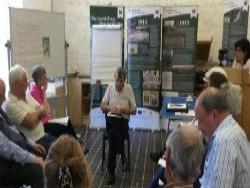 For two days, on the banks of the Erne surrounded by the historic buildings of the Watergate, Maguire Castle and Inniskillings Barracks, the Living Legacies team worked in intense creativity with two writers groups, the Fermanagh Writers and the Omagh Robins. The Living Legacies 2016 Writers’ Summer School was a new departure for the Engagement Centre. The Centre was established in January 2014 as one of five First World War Engagement Centres in the UK which work alongside community groups to explore the war period and its meaning for people today. It includes academics working at Glasgow, Newcastle, Queen’s and Ulster Universities, amongst others, who have teamed with community groups, museum experts and people across the heritage and cultural sectors to produce new knowledge and understanding of the period. The Summer School built upon previous initiatives events hosted by Living Legacies, including: Medals All Round Research Initiative (MARRI), which resulted in Of Bicycles and Fallow Fields, a WW1 drama written and performed by Omagh Robins; the event Music and Memories held at the Inniskillings Museum in June 2015, during which musician Tracey MacRory talked about the wartime inspiration for her music; and the visit of the Fermanagh Writers to Northern Ireland War Memorial in March 2016.
For two days, on the banks of the Erne surrounded by the historic buildings of the Watergate, Maguire Castle and Inniskillings Barracks, the Living Legacies team worked in intense creativity with two writers groups, the Fermanagh Writers and the Omagh Robins. The Living Legacies 2016 Writers’ Summer School was a new departure for the Engagement Centre. The Centre was established in January 2014 as one of five First World War Engagement Centres in the UK which work alongside community groups to explore the war period and its meaning for people today. It includes academics working at Glasgow, Newcastle, Queen’s and Ulster Universities, amongst others, who have teamed with community groups, museum experts and people across the heritage and cultural sectors to produce new knowledge and understanding of the period. The Summer School built upon previous initiatives events hosted by Living Legacies, including: Medals All Round Research Initiative (MARRI), which resulted in Of Bicycles and Fallow Fields, a WW1 drama written and performed by Omagh Robins; the event Music and Memories held at the Inniskillings Museum in June 2015, during which musician Tracey MacRory talked about the wartime inspiration for her music; and the visit of the Fermanagh Writers to Northern Ireland War Memorial in March 2016.
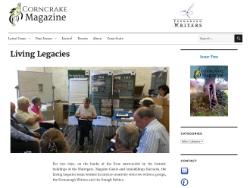
The writers made new and deeper connections with the Living Legacies team; learned from the experiences of Marion Maxwell, Bellanaleck History Group, and their Cleenish Island project funded by HLF First World War Then and Now scheme; and made new friends within the recently amalgamated of Fermanagh & Omagh District Council. The two days represented not only a significant time commitment from the participants, but also one that would challenge their preconceptions of the war period and why we should remember. By the end they had produced new work, learned new skills about their craft, and had greater understanding of the impact and legacy of the First World War period. For the Living Legacies team the two days provided an invaluable insight into the multiple meanings that can be drawn from the war period and how each person constructs that past in a way that has relevance for their contemporary lives. Collaborations were lively, the mood was one of generosity and mindfulness, and the work read on the final day was moving and deeply insightful.